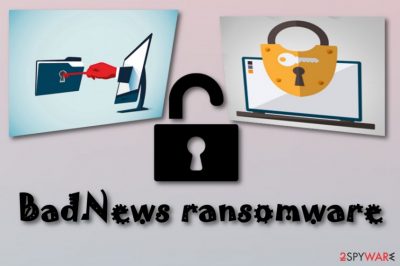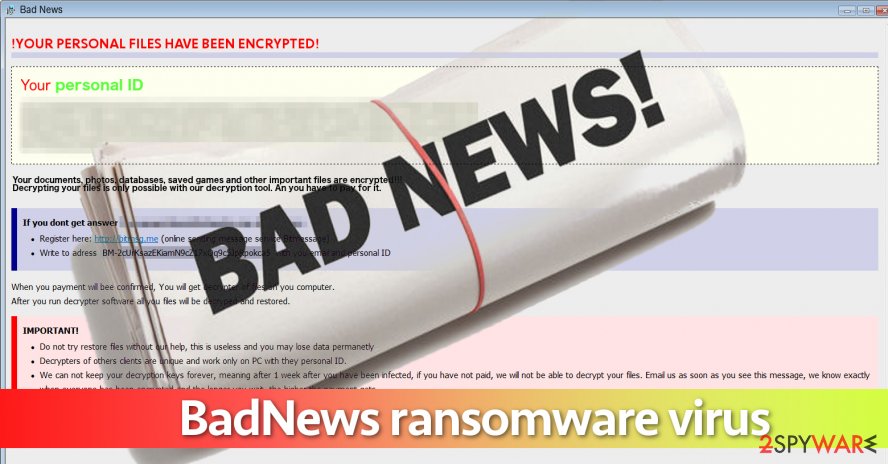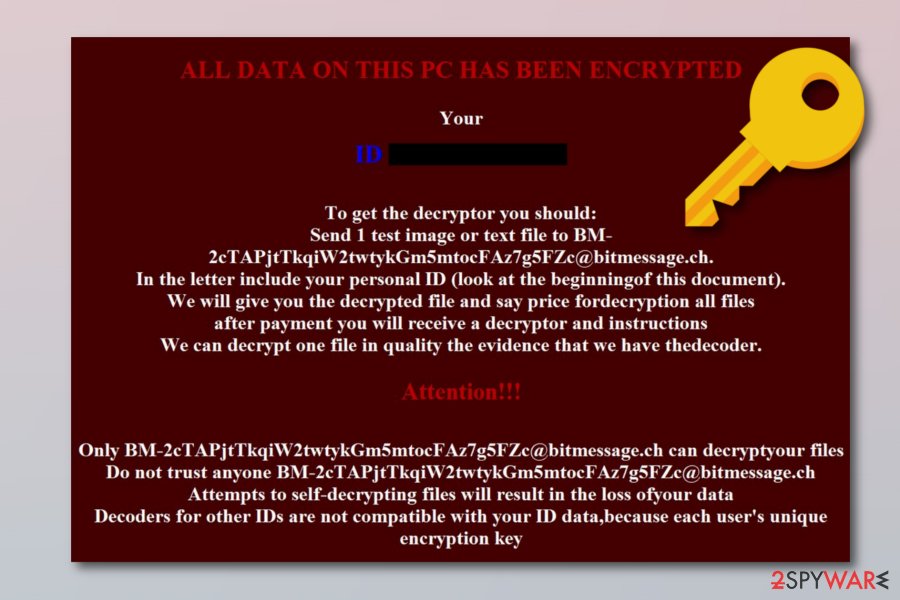BadNews ransomware / virus (Removal Guide) - Aug 2018 update
BadNews virus Removal Guide
What is BadNews ransomware virus?
BadNews ransomware – dangerous cryptovirus which locks important files and requires the money for their decryption

BadNews virus is a ransomware-type virus which is meant to encrypt[1] all victim’s files and demand a ransom in exchange for a decryption key[2]. To put it simply, the program uses a public key for data encryption and then creates a decryption key (private key), which it stores on its server and hides it securely. When Bad News ransomware steps into the system, it encrypts files and adds the ID [victim's_ID].BadNews file extension to them. Finally, the virus launches a window and displays an HTML message named How To Decode Files.hta. Crooks announce about the encryption and demand a particular ransom for file decryption.
| Name | BadNews |
|---|---|
| Category | Ransomware |
| Extension | ID [victim's_ID].BadNews |
| Ransom message name | How To Decode Files.hta |
| Ransom | No closer details are provided for this case |
| Encryption algorithm | AES and RSA |
| Prevention | Install strong antivirus protection |
| Removal | Get FortectIntego and eliminate the virus effectively |
The ransom message looks like this:
ALL DATA ON THIS PC HAS BEEN ENCRYPTED
Your
ID iHupX3tzhxqXTo get the decryptor you should:
Send 1 test image or text file to BM-2cTAPjtTkqiW2twtykGm5mtocFAz7g5FZc@bitmessage.ch.
In the letter include your personal ID (look at the beginningof this document).
We will give you the decrypted file and say price fordecryption all files
after payment you will receive a decryptor and instructions
We can decrypt one file in quality the evidence that we have thedecoder.Attention!!!
Only BM-2cTAPjtTkqiW2twtykGm5cc0pyc@tfr0mpcr1sk@bitmessage.ch can decryptyour files
Do not trust anyone BM-2cTAPjtTkqiW2twtykGm5mtocFAz7g5FZc@bitmessage.ch
Attempts to self-decrypting files will result in the loss ofyour data
Decoders for other IDs are not compatible with your ID data,because each user's unique encryption key
The ransom price is currently unknown in this situation as there are no certain details provided. However, cybercrooks who spread ransomware such as BadNews ransomware usually urge for a type o cryptocurrency, e.g., Bitcoin or Monero. Moreover, the price often varies between $500 and $1500.
Nobody wants to lose all files in a second; however, that doesn’t mean that you should go and pay the ransom that cybercriminals hiding behind BadNews demand paying. You risk being left out without access to your files and also without a considerable amount of money in case cyber criminals decide not to provide you with the decryption key.
Therefore, our team suggests removing the virus instead and taking all possible actions to recover files for free. If you do not have an antivirus program, you should install anti-malware software (because it is capable of detecting a wider range of computer infections[3] than just viruses). Our team says that FortectIntego software is the one users should rely on. To remove BadNews ransomware, firstly restart the computer using instructions presented in the elimination guide.
Moreover, performing the BadNews ransomware removal is strongly recommendable as some ransomware-type viruses can “clean the way” for other malware forms. When your computer security level decreases, you might catch a serious infection and suffer even worse consequences. Be aware of such activity, eliminate the cyber threat ASAP.

Ransomware attack prevention tips
According to LosVirus.es malware experts[4], ransomware attacks should be avoided because, in the majority of cases, viruses manage to distort the victim’s files in a way that they become unrecoverable. To avoid the risk of losing files for good, you should do everything to avoid ransomware attacks. That is rather an easy task to do[5].
First of all, you should install anti-malware software to recognize malicious attempts to encrypt your files; secondly, you should create a backup of the most important data. To create a backup[6], take an external disk, plug it into your computer and transfer the most important files to the external device. Always keep such data storage devices unplugged from your PC – this way, the virus won’t be able to reach and infect them. Backups can be used anytime when you need them.
Moreover, avoid opening attachments that are clipped to phishing messages. Spam emails often carry hazardous content with them which comes in the form of a clipped attachment or a link. Additionally, install strong antivirus protection to prevent various infections. If you do so, you have a bigger chance of avoiding ransomware attacks as well.
Remove BadNews ransomware from your PC system by performing some steps

When strong ransomware virus strikes, the situation becomes unenviable as the most important data becomes unavailable for the use. However, one should not give up and take actions to remove BadNews virus from the system. That is rather a simple thing to do, but only if you have the anti-spyware software. We suggest installing FortectIntego, SpyHunter 5Combo Cleaner, or Malwarebytes. Speaking about ransomware viruses, manual removal method is not a recommended one.
Therefore, we suggest users using tools that we recommend for BadNews removal. Be cautious while performing every step. After you proceed with the elimination, there is one more goal you need to accomplish to secure your computer system fully. Performing system backups is a necessary action – you need to make sure that all virus-related content was removed from your computer successfully.
Taking about data recovery, you can try some third-party software that we have provided below this article. If you perform each step as shown in the instructions, these methods might help you to get your corrupted files back to their starter positions.
Getting rid of BadNews virus. Follow these steps
Manual removal using Safe Mode
Reboot your computer system to Safe Mode with Networking. You can activate this function with the help of these instructions:
Important! →
Manual removal guide might be too complicated for regular computer users. It requires advanced IT knowledge to be performed correctly (if vital system files are removed or damaged, it might result in full Windows compromise), and it also might take hours to complete. Therefore, we highly advise using the automatic method provided above instead.
Step 1. Access Safe Mode with Networking
Manual malware removal should be best performed in the Safe Mode environment.
Windows 7 / Vista / XP
- Click Start > Shutdown > Restart > OK.
- When your computer becomes active, start pressing F8 button (if that does not work, try F2, F12, Del, etc. – it all depends on your motherboard model) multiple times until you see the Advanced Boot Options window.
- Select Safe Mode with Networking from the list.

Windows 10 / Windows 8
- Right-click on Start button and select Settings.

- Scroll down to pick Update & Security.

- On the left side of the window, pick Recovery.
- Now scroll down to find Advanced Startup section.
- Click Restart now.

- Select Troubleshoot.

- Go to Advanced options.

- Select Startup Settings.

- Press Restart.
- Now press 5 or click 5) Enable Safe Mode with Networking.

Step 2. Shut down suspicious processes
Windows Task Manager is a useful tool that shows all the processes running in the background. If malware is running a process, you need to shut it down:
- Press Ctrl + Shift + Esc on your keyboard to open Windows Task Manager.
- Click on More details.

- Scroll down to Background processes section, and look for anything suspicious.
- Right-click and select Open file location.

- Go back to the process, right-click and pick End Task.

- Delete the contents of the malicious folder.
Step 3. Check program Startup
- Press Ctrl + Shift + Esc on your keyboard to open Windows Task Manager.
- Go to Startup tab.
- Right-click on the suspicious program and pick Disable.

Step 4. Delete virus files
Malware-related files can be found in various places within your computer. Here are instructions that could help you find them:
- Type in Disk Cleanup in Windows search and press Enter.

- Select the drive you want to clean (C: is your main drive by default and is likely to be the one that has malicious files in).
- Scroll through the Files to delete list and select the following:
Temporary Internet Files
Downloads
Recycle Bin
Temporary files - Pick Clean up system files.

- You can also look for other malicious files hidden in the following folders (type these entries in Windows Search and press Enter):
%AppData%
%LocalAppData%
%ProgramData%
%WinDir%
After you are finished, reboot the PC in normal mode.
Remove BadNews using System Restore
Enable the System Restore feature by following this guide:
-
Step 1: Reboot your computer to Safe Mode with Command Prompt
Windows 7 / Vista / XP- Click Start → Shutdown → Restart → OK.
- When your computer becomes active, start pressing F8 multiple times until you see the Advanced Boot Options window.
-
Select Command Prompt from the list

Windows 10 / Windows 8- Press the Power button at the Windows login screen. Now press and hold Shift, which is on your keyboard, and click Restart..
- Now select Troubleshoot → Advanced options → Startup Settings and finally press Restart.
-
Once your computer becomes active, select Enable Safe Mode with Command Prompt in Startup Settings window.

-
Step 2: Restore your system files and settings
-
Once the Command Prompt window shows up, enter cd restore and click Enter.

-
Now type rstrui.exe and press Enter again..

-
When a new window shows up, click Next and select your restore point that is prior the infiltration of BadNews. After doing that, click Next.


-
Now click Yes to start system restore.

-
Once the Command Prompt window shows up, enter cd restore and click Enter.
Bonus: Recover your data
Guide which is presented above is supposed to help you remove BadNews from your computer. To recover your encrypted files, we recommend using a detailed guide prepared by 2-spyware.com security experts.If you want to get important files back to as they were before the ransomware-type virus managed to encrypt them, you can try some of these methods.
If your files are encrypted by BadNews, you can use several methods to restore them:
Restore encrypted files with Data Recovery Pro
Data Recovery Tool is the special software that can restore lost files. Try using this tool for the recovery of your encrypted data by following these steps:
- Download Data Recovery Pro;
- Follow the steps of Data Recovery Setup and install the program on your computer;
- Launch it and scan your computer for files encrypted by BadNews ransomware;
- Restore them.
Restore files with the help of Windows Previous Versions feature. Try this method:
Windows Previous Versions can help you to recover lost data. This technique works only if you enabled the System Restore function a while ago.
- Find an encrypted file you need to restore and right-click on it;
- Select “Properties” and go to “Previous versions” tab;
- Here, check each of available copies of the file in “Folder versions”. You should select the version you want to recover and click “Restore”.
Try Shadow Explorer to get important files back:
You can use this method to restore corrupted data. However, it will not work if the virus did not damage Shadow Volume Copies of locked files.
- Download Shadow Explorer (http://shadowexplorer.com/);
- Follow a Shadow Explorer Setup Wizard and install this application on your computer;
- Launch the program and go through the drop down menu on the top left corner to select the disk of your encrypted data. Check what folders are there;
- Right-click on the folder you want to restore and select “Export”. You can also select where you want it to be stored.
There is no original BadNews decryptor discovered yet.
Finally, you should always think about the protection of crypto-ransomwares. In order to protect your computer from BadNews and other ransomwares, use a reputable anti-spyware, such as FortectIntego, SpyHunter 5Combo Cleaner or Malwarebytes
How to prevent from getting ransomware
Choose a proper web browser and improve your safety with a VPN tool
Online spying has got momentum in recent years and people are getting more and more interested in how to protect their privacy online. One of the basic means to add a layer of security – choose the most private and secure web browser. Although web browsers can't grant full privacy protection and security, some of them are much better at sandboxing, HTTPS upgrading, active content blocking, tracking blocking, phishing protection, and similar privacy-oriented features. However, if you want true anonymity, we suggest you employ a powerful Private Internet Access VPN – it can encrypt all the traffic that comes and goes out of your computer, preventing tracking completely.
Lost your files? Use data recovery software
While some files located on any computer are replaceable or useless, others can be extremely valuable. Family photos, work documents, school projects – these are types of files that we don't want to lose. Unfortunately, there are many ways how unexpected data loss can occur: power cuts, Blue Screen of Death errors, hardware failures, crypto-malware attack, or even accidental deletion.
To ensure that all the files remain intact, you should prepare regular data backups. You can choose cloud-based or physical copies you could restore from later in case of a disaster. If your backups were lost as well or you never bothered to prepare any, Data Recovery Pro can be your only hope to retrieve your invaluable files.
- ^ Jeff Tyson. How Encryption Works. HowStuffWorks. Learn How Everything Works!.
- ^ Master decryption key released for Teslacrypt ransomware. Threatpost. The first stop for security news.
- ^ Andra Zaharia. 10 Warning Signs that Your Computer is Malware-Infected. Heimdall Security. Builds industry-leading patch management, financial security and data protection software.
- ^ LosVirus.es. LosVirus. Cybersecurity news site.
- ^ Dan Raywood. How to avoid being caught out by ransomware. ComputerWeekly. Information technology (IT) news and IT jobs.
- ^ Why do I need backup and what options do I have for that?. 2-Spyware. Fighting against spyware.





















